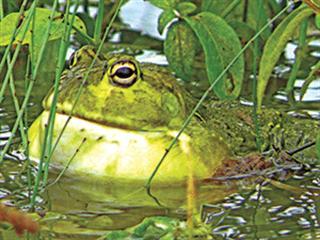
My wife woke me at 3am after hearing something outside. We lay in bed listening, wondering what it was. Suddenly an unearthly howl reverberated not far from our bedroom window. It was a hyena, but its call was different this time. Another hyena answered from across the dry riverbed. Soon more signalled that they were coming. Within minutes, the air was filled with a cacophony of shrieks, giggles, growls and the sound of crushing bone.
They had killed something, painting a sound picture for us of what was going on out there in the darkness. At 4:30am my wife got up, gently bumping into something. The hyenas immediately became quiet, completing the rest of their feast in silence until dawn, when we went out. All we found was the neck vertebrae and ribcage of a kudu. The message sent by the first hyenas at the scene was so effective that all within earshot gathered to demolish almost the entire carcass.
Communicating through sound
Most sounds in nature carry a message and most animals respond to sound waves. Even primitive life forms with no special hearing organs respond to sound waves. Earthworms, for example, retreat deeper into their burrows when sound-vibrations warn them that a fisherman has started to dig for them. Higher animals, on the other hand, rely heavily on their ears to interpret different sounds around them.
Sound waves carry better in water than in air. Low-frequency sounds travel well through water or dense vegetation, while high-frequency sounds transmit well through open air. The sounds animals produce and the design of their ears often reflect something about their habitat.
Underwater sound
Fish have no external ears, but they hear water-borne, low-frequency sounds very well. Noises caused by boat and bank fishermen can have a detrimental effect on their fishing success. I’ve even seen barbel move to deeper water when anglers talk loudly on the bank. Fish produce an astonishing variety of grunts and other noises, making the ocean alive with sound, but at frequencies too low for us to hear.
But dolphins produce high-pitched squeals and whistles which, like the hyenas’ calls, carry messages of large congregations of baitfish to pods far away, while being inaudible to the fish they hunt. Hippos make more noise underwater than above. Like the roars of mating crocodiles, these sounds travel further up and down the water than those made above the surface.
A microphone off the US coast picked up the sound of an explosion of 2kg TNT off the South African coast – confirmation that the sound of whales singing can travel vast distances under water, allegedly even around the globe’s oceans. Imagine the acoustic effect underwater nuclear testing has on marine life. The sonar of whales and dolphins, as well as that of bats and oilbirds navigating at night, is ultra-high-frequency sound.

The world’s largest ears. They serve many functions – hearing, visual communication and thermoregulation.
Sound on land
Land animals also use sound to communicate. Sound plays a crucial role in the lives of amphibians like frogs with external eardrums merely covered by a layer of skin. Frogs aren’t only highly vocal – they can distinguish slight differences in calls made by different species, even in a deafening frog-chorus. Few terrestrial reptiles, except geckos, produce any vocal sounds. In most lizards the ear is clearly visible, its membranous eardrum very close to the opening of its ear canal.
The ears of some burrowing lizards are so rudimentary that it’s thought that snakes, which have no external ear openings and are totally deaf to airborne sound, evolved from them. In contrast, birds are the most vocal of all animals, but the subject of birdsong is a story on its own and we’ll discuss it at a later stage.Mammals are the only animals with external cartilaginous ears or pinnae, so their hearing is perhaps the most sensitive.
Elephants have the largest ears and can detect ultra-low infra-sound to communicate extreme distances overland. Like a hare, which for its size has the longest ears, elephants also use their ears as radiators of excess body heat. Depending on where and how mammals live, their highly manoeuvrable ears vary in size and shape, as do the sounds they produce.
Open plains antelope, such as oribi, reedbuck and some gazelles, usually have smallish ears. The longer ears of desert gazelle, such as springbok, are an adaptation for thermoregulation in a hot and arid environment. High pitched whistle-like alarm calls are also characteristic of many open-space antelope. Most woodland and savannah antelope produce lower-pitched snorts, while the spiral-horned lovers of forest or thick vegetation utter a harsh low-pitched, bush-penetrating bark.
They also have large ears to pick up the slightest sound muffled by thick vegetation. In contrast to the large ears of forest or bush dwelling giant eland, the ears of the closely related Cape eland, adapted to open habitat, are very small. Compared to carnivores such as leopards, primates’ hearing is poor and so baboons and monkeys make easy nocturnal prey. If in the bush, you want to hear more and be heard less, the password is “hush”













